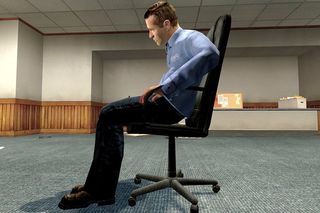Are games killing us?
Enter the uncomfortable world of eThrombosis
Sept 19, 2007
Kim Kyung-jae lived for games. The 24-year-old South Korean was not employed full-time, and spent most of his leisure hours at a LAN cafe in the city of Kwangju. His game of choice: NCsoft's Mu Online, a medieval fantasy MMORPG. The last time he played, the session lasted nearly three and a half days. Witnesses report he only left his seat to buy cigarettes or visit the toilet. On October 9, 2002, after 86 almost straight hours of Mu, he collapsed. Regaining consciousness briefly, he staggered to the toilet, where he collapsed again. He didn't recover. Kim Kyung-jae died for games.
The exact cause of his demise has been attributed to both "exhaustion" and deep-vein thrombosis (DVT). This latter has been wholeheartedly adopted by sensationalist media as yet another reason why games are bad for the world. It's a horrible condition, for sure. Prolonged inactivity impedes bloodflow around your body, causing clots to form in the deeper veins - usually the legs, but occasionally the arms as well.
Having the clot at all is bad enough, but it can become dislodged and travel through the vein and rest near essential organs such as the lungs, massively increasing the chance of pulmonary embolism. That's medical talk for "completely blocking the flow of blood in a vein." In other words, it starves the lungs. Symptoms include difficult or painful breathing, and, in some cases, death. Note, though, that just one in every thousand people ever contracts deep-vein thrombosis, and of those only 1-5% die from it.

Kim Kyung-jae was the first reported person to die from playing a videogame for too long, but not the last. Just a few weeks later in Taiwan, 27-year-old Lien Wen-cheng undertook a 32-hour gaming session in a LAN cafe. He too collapsed in the toilet, reportedly foaming at the mouth and bleeding from the nose. Three years later, another Korean, a 28-year-old man named only as "Lee," played Starcraft for some 50 hours, and met a similar fate. "We presume the cause of death was heart failure stemming from exhaustion," police stated at the time. Conjecture, though not proof, has also blamed DVT.
Tastelessly, the computing-related instances of DVT have been dubbed "eThrombosis." Though actual reported instances are few and far between, a few non-fatal cases have been documented. In 2003, a New Zealander passed out but recovered from this condition. It was attributed to his spending most of each day at his PC. In 2004, 14-year-old Dominic Patrick from Merseyside was hospitalized after spending ten hours knelt in front of his Xbox.
Sign up to the 12DOVE Newsletter
Weekly digests, tales from the communities you love, and more
You could pass off eThrombosis as a by-product of the famously intense Korean gaming culture, but almost all these cases were before the release of World of Warcraft, Lord of the Rings Online, and EVE. Before broadband was anywhere near as cheap and prevalent as it is now. We westerners want something else from our games these days: we want to stay in one game for as long as possible. Kim Kyung-jae's 86 hours might be something we'd never do, but Dominic Patrick's ten hours and even Lien Wen-cheng's 32 are not even remotely beyond the realm of possibility in the world circa 2007. Currently, eThrombosis deaths can be counted on the fingers of one hand, but as we become a culture ever more centered around sitting in front of a screen, this figure could rise.












